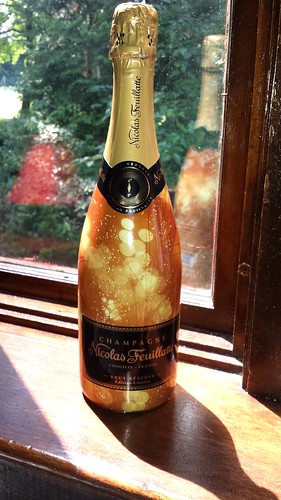It’s common to hear wine professionals comment on the size of bubbles as being some indication of quality. A good quality Champagne has a steady stream of fine bubbles, while an inexpensive Prosecco has much larger bubbles. That’s how the received wisdom goes.—Jamie Goode's Wine Blog
But it’s a myth.
How many bubbles does a bottle of Champagne have in it? Zero. The same goes for a bottle of Prosecco, or Cava, or English sparkling wine. They all have carbon dioxide dissolved in them, up to pressures of 6 atmospheres. It’s only when they are poured into a glass that the bubbles appear, and the nature of the bubble largely depends on the characteristics of the glass.
It’s also a myth that the way that the carbon dioxide gets into the wine determines the bubble size. Once carbon dioxide is in the wine it doesn’t matter whether it was produced by yeasts or pumped in from a cylinder. It’s the same gas.
So how do glasses affect bubble size? Bubbles are formed from what is known as nucleation sites in the glass. Typically these will be small bits of cellulose fibre (for example, from cleaning cloths) or other imperfections. As the glass is filled, these will harbour microscopic air bubbles that are then able to initiate bubble formation in the wine. The dissolved carbon dioxide comes out of solution at these sites and a stream of bubbles is released. Some glasses are deliberately etched at the bottom to create nucleation sites that will cause a pretty stream of bubbles to flow upwards.
If you were to clean a glass perfectly, for example by using phosphoric acid, then there would be no nucleation sites and no bubbles.
14 August 2015.
But why exactly does that fine-mousse of a Champagne dissipate so rapidly, whereas the foamy head of a well-made beer lingers on? Here, Charles Bamforth, at the University of California, Davis, educator to 'craft' brewers, explains:
Foam is an inherently unstable phenomenon because of the huge increase in surface area within an aqueous system that is counter to the force of surface tension. That beer foam is stable, unlike that in richly carbonated beverages such as champagne and sodas [and cider], is due to the presence of surface-active agents in beer. The main foam-stabilizing agents in beer are hydrophobic polypeptides derived from grain. These molecules cross-link with the bitter iso-alpha-acids derived from hops to render the foam more rigid and not only more stable but also adhere to the side of the glass as the beer is consumed.— The Oxford Companion to Beer: Oxford University Press, 2012.
In other words, beer has proteins from barley and wheat, and compounds from hops. Wine, from grapes, does not.
Long-lasting bubbles or not, the quality of the wine inside a bottle of Champagne does make a difference. The yeasty, toasty, elegant, well-acidified flavor of a French Champagne is a thing of beauty.
In France, Champagne and sparkling wine are drinks enjoyed everyday, not only reserved for special occasions.
So said Isabelle Bricout, the U.S. Business Development Manager for Champagne Nicolas Feuillatte of Épernay, France, when hosting a recent luncheon at L'Auberge Chez Francois, in Great Falls, Virginia.
Words to lunch by, in America.
-----more-----
- The bottle of Nicolas Feuillatte Brut was posed on a window ledge in the afternoon sun, wrapped in a preview of its holiday finery. The photo was taken on 5 August, 2015, using the camera function of a Samsung Galaxy S4.
- Caveat lector: As a representative for Select Wines, Inc. —a wine and beer wholesaler in northern Virginia— I sell the Champagnes of Nicolas Feuillatte. Any opinions here are mine alone.
- Pic(k) of the Week: one in a weekly series of personal photos, usually posted on Saturdays, and often, but not always, with a good fermentable as a subject.
- Commercial reproduction requires explicit permission, as per Creative Commons.
- For more from YFGF:
- Follow on Twitter: @Cizauskas.
- Like on Facebook: YoursForGoodFermentables.
- Follow on Flickr: Cizauskas.
- Follow on Instagram: @tcizauskas.











Great post! Thanks for sharing. I have wondered about carbonation pertaining to cider, and this answered a lot of my questions.
ReplyDelete